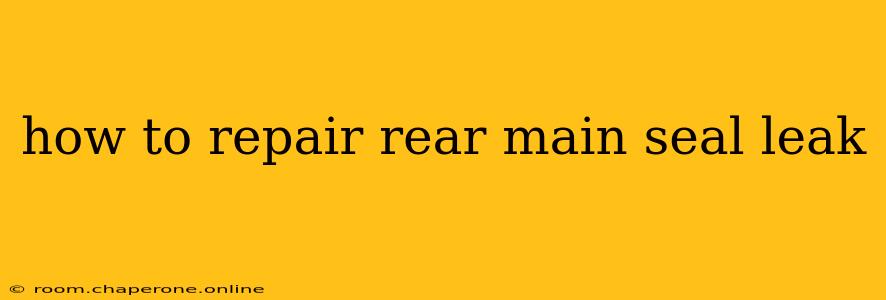A rear main seal leak is a frustrating but common problem for car owners. This seal, located where the engine's crankshaft meets the transmission, prevents oil from escaping. When it fails, it can lead to unsightly oil stains, reduced engine performance, and even catastrophic engine damage if left unaddressed. While replacing a rear main seal can seem daunting, this comprehensive guide will walk you through the process, equipping you with the knowledge to tackle this repair effectively.
Understanding the Rear Main Seal and its Failure
Before diving into the repair process, it's crucial to understand what a rear main seal is and why it fails. The rear main seal is a critical component responsible for preventing oil leakage from the engine's crankshaft. Over time, this seal can wear down due to several factors:
- Age and Wear: Like any rubber component, the seal degrades with age and use, becoming brittle and losing its elasticity. This is often the most common cause of failure.
- Heat: Excessive heat from the engine can accelerate the deterioration of the seal.
- Improper Installation: Incorrect installation during engine assembly or previous repairs can lead to premature seal failure.
- Crankshaft Damage: Scratches or damage to the crankshaft can compromise the seal's integrity.
Assessing the Severity of the Leak
Before embarking on a repair, you need to properly assess the extent of the leak. A small weep may only require monitoring, while a significant leak necessitates immediate action. Consider these factors:
- Amount of Oil Leakage: A small drip is less concerning than a substantial oil stream.
- Oil Consumption: Check your oil level regularly. Rapid oil loss points to a significant leak.
- Oil Stain Location: The location and extent of the oil stain can indicate the severity of the leak.
Repair Options: When to DIY and When to Seek Professional Help
Repairing a rear main seal leak is a challenging job, typically requiring significant mechanical expertise and specialized tools. Consider these factors when deciding whether to attempt a DIY repair:
- Your Mechanical Skills: This repair requires advanced mechanical skills and experience. If you lack this experience, it's best to leave it to a professional mechanic.
- Vehicle Accessibility: Access to the rear main seal varies greatly depending on the vehicle's make and model. Some vehicles offer easier access than others.
- Cost vs. Benefit: Weigh the cost of purchasing specialized tools and the time investment against the cost of professional repair.
For most car owners, professional repair is highly recommended. An improperly performed repair can lead to further damage and costly consequences.
The Repair Process (Professional Level Overview):
While a detailed step-by-step DIY guide is impractical here due to the complexity and variability across vehicle models, a general overview of the professional repair process includes:
1. Preparation:
- Vehicle Preparation: The vehicle needs to be securely supported on jack stands. Disconnect the battery.
- Drain Engine Oil: This is essential before commencing any disassembly.
- Component Removal: Transmission removal, flywheel removal, and other components may be required depending on the vehicle.
2. Seal Replacement:
- Seal Removal: Carefully remove the old rear main seal, taking care not to damage the crankshaft.
- Crankshaft Inspection: Inspect the crankshaft for any damage. Any damage necessitates repair or replacement.
- Seal Installation: Install the new rear main seal correctly, using appropriate tools and techniques to avoid damage.
3. Reassembly:
- Reinstallation: Carefully reassemble all components in reverse order of removal.
- Fluid Refills: Refill engine oil, transmission fluid (if applicable), and coolant.
- Testing: Start the engine and carefully monitor for any leaks.
Preventing Future Rear Main Seal Leaks
Regular maintenance plays a vital role in extending the lifespan of your rear main seal and preventing future leaks. This includes:
- Regular Oil Changes: Use the correct grade and type of oil recommended for your vehicle.
- Regular Inspections: Regularly check for oil leaks and address any issues promptly.
- Proper Engine Cooling: Ensure your cooling system functions correctly to prevent excessive engine heat.
This guide provides a foundational understanding of rear main seal leaks and the associated repair processes. Remember, the complexity of this repair necessitates professional intervention in most cases. If you're unsure about tackling this repair yourself, seeking help from a qualified mechanic is the safest and most effective approach.

